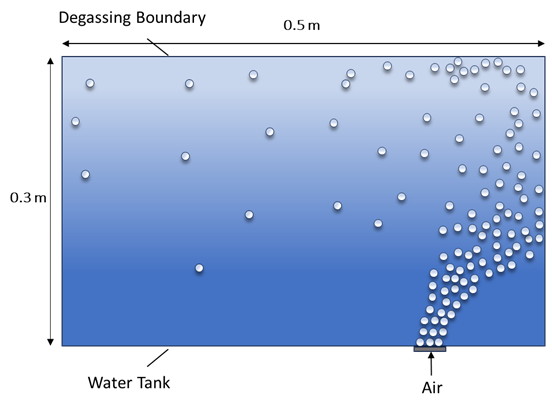Eulerian: Aeration Tank Degassing
In industry, aeration tanks facilitate the exchange of gases in various processes within a liquid medium. Degassing is a procedure that actively removes gases from a liquid, such as eliminating excess gases that can build up during the biological treatment of organic pollutants, a process particularly common in waste-water treatment.
This tutorial demonstrates the workflow for setting up a degassing boundary for a simplified aeration tank with a length of 0.5m, a width of 0.1m, and a height of 0.3m. The tank is completely filled with water. The air enters the tank at a velocity of 5 m/s through a perforated plate that has an open area of 4%. Only air can leave through the top of the tank.
The following diagram shows the aeration tank configuration:

In this tutorial, the Eulerian Multiphase (EMP) model is used to simulate the steady turbulent flow in the aeration tank. This model is suitable for capturing the fluid dynamics and turbulence associated with dispersed air in water. The Eulerian Multiphase (EMP) model also provides the Drag Force, Turbulent Dispersion Force, and Virtual Mass Force models which take into account the effects of resistance, displacement, and turbulent structures when air bubbles and water interact.
The degassing top surface of the tank is modeled using a phase-permeable wall boundary, which permits only air to pass through while restricting the flow of water. The inflow of air through the perforated plate is modeled by using a velocity inlet boundary at which the volume fraction of air is 0.04.
As a result, the volume fraction of air in the tank and the mass flow rate of air at the degassing boundary are used to illustrate the air rise up in the tank. Simcenter STAR-CCM+ automatically calculates the mass flow rate through the phase-permeable boundary—the degassing rate. This rate is plotted using phase mass flow reports, and the results show that there is no water flow through the degassing boundary.